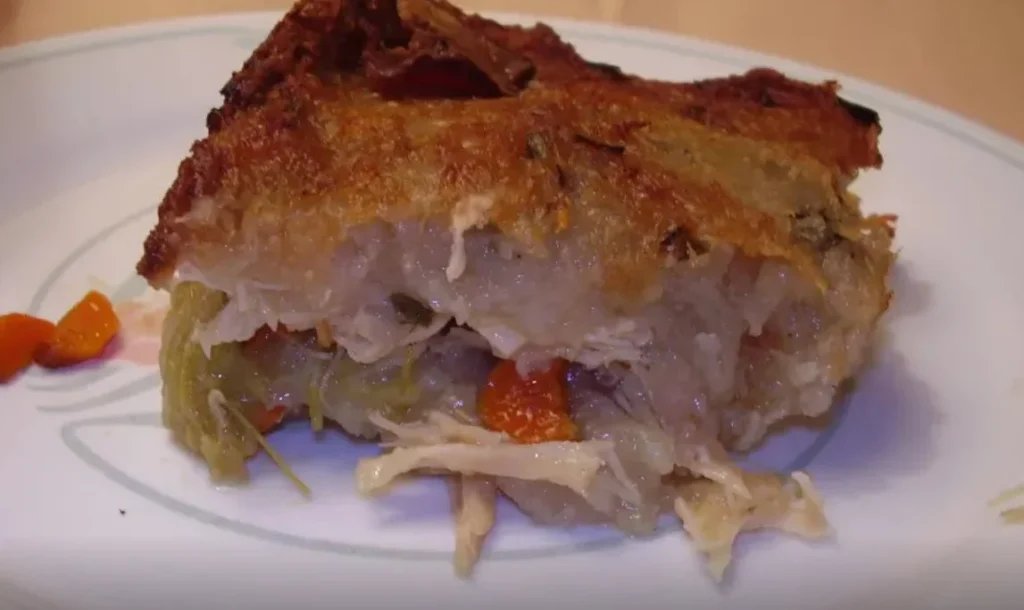I love sharing recipes that carry history, and rappie pie is one of those dishes that feels like a story on a plate. I first discovered this Acadian classic when I wanted something hearty, filling, and deeply tied to tradition. Rappie pie, sometimes called rapûre or râpure, is not just food—it’s heritage. The dish comes from the Acadians of Nova Scotia, and it has been passed down for generations.

What makes it stand out is the way potatoes get transformed. Instead of just boiling or mashing, I grate them, squeeze out the liquid, and bring them back to life with hot, flavorful chicken broth. Then I layer the potato mixture with tender chicken and bake it until the top turns golden brown and crisp. The result is comfort food that warms me right down to my soul.
Whenever I make rappie pie, I know I’m stepping into a tradition much older than me. The process takes time and patience, but the reward is a dish that feels rustic, rich, and satisfying. This isn’t just a recipe—it’s an experience that connects me with history while filling my kitchen with incredible aromas.
How To Make Rappie Pie Recipe?
- Preparation time: About 1 hour (mostly peeling, grating, broth preparation)
- Cooking time: Approximately 2 to 3 hours (broth simmering plus baking time)
- Total time: 3 to 4 hours
- Course: Main course
- Difficulty: Moderate — takes time and effort, but I promise it’s worth it
- Cuisine: Acadian / Canadian Maritime
- Yield: Serves about 8 people (one 10×14-inch or large casserole pan)
Equipment You’ll Need
- Large pot for making broth
- Grater or juicer (or food processor with grating attachment or cheesecloth method)
- Cheesecloth or clean cloth/towel for squeezing potatoes
- Large mixing bowl
- Greased baking pan (metal; avoid glass)
- Baking sheet or casserole dish
- Oven preheated and ready!
Ingredients
- For the broth & chicken:
- 1 whole chicken (about 3–4 lbs), or chicken pieces
- 2 onions (quartered), plus 1 onion (chopped for layering), optional
- 2–3 carrots, chopped (optional)
- 2 celery stalks, chopped (optional)
- Fresh herbs (thyme, parsley) if you like
- Water to cover
- Salt and pepper to taste
- For the potato base:
- About 10 pounds potatoes (floury type best), peeled
- Alternatively, store-bought grated potato blocks if you can find them.
- Seasonings & layering:
- Salt & black pepper
- Butter, bacon fat, or salt pork to grease pan and top
- Optional: salted green onions for that authentic Acadian twist.
Step-by-Step Instructions
1. Make the Broth
I place the chicken, quartered onions (and carrots/celery if I’m using them) into a large pot. I fill it with water to cover, season with salt and pepper (and herbs if I’m feeling fancy), bring it to a gentle boil, skimming any foam, then reduce to a simmer. I let it cook for about 1.5 to 2 hours until the chicken is falling-apart tender.
When it’s done, I remove the chicken, let it cool just enough to handle, then pull the meat off the bone into bite-sized pieces. I carefully reserve and strain the broth—this becomes my golden flavor base.
2. Prepare the Potato Base
Meanwhile, I peel the potatoes and quickly rinse them in cold water to prevent browning. Then I grate them finely (or run through a juicer or food processor). I gather the grated potato in cheesecloth and firmly squeeze out every drop of potato liquid—this step defines the texture later.
I discard the liquid—or I sometimes measure how much liquid came out and plan to add that much hot broth back in later for consistency.
3. Bring It Together
Now I place the dried potato pulp in a large bowl. I slowly ladle in hot chicken broth—about 2 cups at a time—stirring constantly until it transforms into a thick, smooth, cake-batter–like consistency.
4. Assemble the Pie
I grease a metal baking pan with butter or bacon fat. I pour half the potato-broth mixture into the pan, spreading it evenly. Then I layer the shredded chicken (and carrots or chopped onions if I’ve added them). I sprinkle in salted green onions if I’m using them too.
Next, I top with the remaining potato mixture, smoothing it out, and dot the top with bits of butter, bacon fat, or salt pork to get that golden, crispy top later.
5. Bake to Golden Glory
I preheat the oven to about 350-400°F (175-200°C). Then I bake the pie for 2 to 3 hours, often starting at a higher heat for crisping, then lowering to gently cook through. The goal is a brown, crackly top and a tender, moist center.
Once it’s done, I let it rest for 20–30 minutes so it sets and isn’t soupy—this makes it much easier to slice neatly.
Nutrition Facts (Per Serving, approx. 8 servings)
- Calories: ~733 kcal
- Fat: ~9 g
- Carbohydrates: ~104 g
- Protein: ~58 g
- Sodium: may be high around 3,800 mg depending on added salt
- Fiber: ~13 g.
Serving Suggestions
When I serve rappie pie, I like to cut it into thick, hearty squares and place them on warm plates. I often drizzle a little molasses over the top for sweetness or add a splash of hot sauce for a kick. Sometimes I melt a pat of butter on each slice, letting it sink into the golden crust.
For balance, I pair the pie with something fresh like a crisp green salad, tangy pickles, or even a side of coleslaw. It’s a rich dish on its own, so simple sides make the meal feel complete without overpowering its traditional flavors.
Tips & Variations
- Save effort: Frozen grated-potato blocks save tons of work if you can find them locally.
- Meat options: Don’t limit yourself to chicken—Acadian tradition welcomes beef, clams, rabbit, venison, even pork.
- Grease tricks: Use bacon fat or salt pork to grease the pan and top for extra flavor and crispiness.
- Texture preference: Use juicer for smoother mash; grate by hand for a more rustic texture. Customize to your mood.
- Prep ahead: You can make the broth a day in advance and refrigerate till ready to assemble to ease the workload.
Health Benefits
I enjoy rappie pie not only for its comforting taste but also for the nourishment it gives me. The potatoes provide a good dose of fiber and potassium, which keep me full and help support healthy digestion.
The chicken adds lean protein, giving me lasting energy and helping my muscles recover after a busy day. Since I make the broth at home, I control the sodium and avoid unnecessary additives. I can also adjust the fats by using butter, bacon fat, or lighter alternatives depending on my needs.
For me, rappie pie is more than just comfort food—it’s a wholesome, satisfying meal that balances tradition with real nourishment.
Note
This dish isn’t for faint hearts—it takes time and elbow grease, especially grating and squeezing potatoes. But each step builds layers of history and flavor that you’ll taste in every bite. The pie might look humble—greyish center and golden edges—but don’t be fooled. The flavor, texture, and memories it evokes make my heart full.
FAQ
1. What meat can I use for rappie pie?
I usually stick with chicken because it’s classic and comforting, but I’ve also seen rappie pies made with rabbit, beef, clams, pork, and even venison. You can adapt it to whatever meat you prefer.
2. Can I make rappie pie ahead of time?
Yes, I sometimes prepare the broth and grate the potatoes a day before. I keep everything in the fridge and assemble it when I’m ready to bake. The baked pie also reheats well in the oven.
3. Why do I need to squeeze the liquid from the potatoes?
This step is essential. The grated potatoes hold a lot of water, and if I skip squeezing them, the pie turns out watery. By pressing out the liquid and replacing it with hot broth, I get the rich, hearty texture that makes rappie pie special.
4. Can I freeze rappie pie?
I don’t usually freeze it because the texture of the potatoes changes. But if I do, I freeze individual portions and reheat them in the oven instead of the microwave to bring back some crispness.
5. What should I serve with rappie pie?
I love adding simple sides like pickles, coleslaw, or a green salad. A drizzle of molasses or a splash of hot sauce on the pie itself also makes it extra delicious.
Conclusion
I’really cherish rappie pie—not just as food, but as tradition, heritage, and comfort. It connects me to Acadian history and every home kitchen that labored to preserve this hearty dish.
If you’re up to the challenge, I promise you’ll be rewarded with a deeply satisfying, soul-warming meal.
Give it a try. Let me know how your version turns out—especially what you serve on the side or sprinkle on top.
